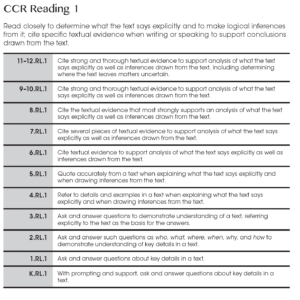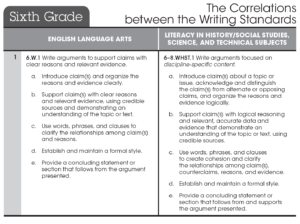Share this article.
When the Common Core State Standards for English Language Arts and Literacy in History/Social Studies, Science, and Technical Subjects were adopted in 2010, their stated purpose was to provide a set of standards for the states to use in supporting all students to be college- and career-ready in literacy no later than the end of high school. These K–12 standards were developed out of the recognition of the value for consistent, real-world learning goals, and the need for all students, regardless of where they go to school, to be prepared for college, career, and life. (National Governors Association Center for Best Practices & Council of Chief State School Officers, 2010)
Developing career- and college-ready students was their stated purpose, but an outcome of their design is a set of standards that easily lend themselves to integrated literacy instruction. When teachers know the embedded patterns within the standards and how to leverage those patterns into integrated literacy scope and sequences, units, and lessons, they can provide instruction that supports students in developing the skills to gather information from text, think critically about that information, and produce their thinking around the information. These are the skills that all college and career ready students have.
And these skills are achievable, if teachers have the knowledge to leverage those patterns to support students. That’s where the series of articles, that this article is part of, comes in.
Let’s get started…
The Call to Integrate Literacy Skills
Built on the foundation of previous work by the states, researchers, and other international models, these standards lay out a vision of what it means to be a successful and literate person in the 21st Century.
“It is true that the future will be full of jobs that do not exist now and challenges we cannot even imagine yet, never mind anticipate accurately. But, whatever those challenges turn out to be, I can guarantee you that they will not be met by people without strong quantitative skills, people who cannot construct a sound argument, people who know little of history or geography or economics, people who cannot write well.” (Tucker, 2013)
The standards are clear in defining the skills and understandings that students need to have and be able to demonstrate in the classroom and then transfer into college and the workplace.
“To be ready for college, workforce training, and life in a technological society, students need the ability to gather, comprehend, evaluate, synthesize, and report on information and ideas, to conduct original research in order to answer questions or solve problems, and to analyze and create a high volume and extensive range of print and nonprint texts in media forms old and new. The need to conduct research and to produce and consume media is embedded into every aspect of today’s curriculum. In like fashion, research and media skills and understandings are embedded throughout the Standards rather than treated in a separate section.” (National Governors Association Center for Best Practices & Council of Chief State School Officers, 2010)
A key design consideration was the focus on results rather than means with the ultimate being career- and college-ready students. Therefore, the standards were judiciously selected and carefully organized into a structure that is patterned, parallel, and progressive from kindergarten to high school. It is these patterns, parallels, and progressions that seamlessly lend themselves to integration.
Designed for Integration
The structure of the standards is based on the strands of literacy, and they have set higher expectations for students to do more with texts.
- Reading: With equal emphasis on text complexity and comprehension, students are expected to discern more from and make fuller use of evidence accessed from a variety of texts.
- Writing: Students are expected to apply the information they gathered in reading by writing to argue, to inform, or to narrate.
- Speaking and Listening: Students are expected to utilize formal and informal skills when communicating and acquiring oral information.
- Language: The “rules” standards, students are expected to develop the skills needed for effective oral and written communication, as well as, the robust vocabulary expected for college and the workforce.
A logical outcome for students who meet the standards will be having the skills in reading, writing, speaking, and listening to be creative, purposeful, and successful in their expression of language. Simply put, the standards are designed to support students in being able to:
- Access information by reading and researching a variety of sources.
- Analyze information by critiquing, clarifying, examining, and discussing it.
- Apply their new learning by communicating it to others through written and spoken language.
For conceptual clarity, the authors divided the standards into the four literacy strands but make it clear that skills within the standards are closely connected and should be integrated in the classroom. That’s why there are embedded features that provide a clear path to integrated literacy instruction. Those features include:
Learning Progressions—
Explicit college and career ready expectations and a clear learning progression for each standard that articulate the mastered skills from kindergarten through high school
Skills within the Standards—
Relevant and teachable skills embedded in every standard that easily integrate with parallel skills
Correlations Between the Strands of Literacy—
Parallel standards that support conceptual redundancy and demonstrate reciprocity between key reading, writing, listening, and speaking standards in each grade-level and between reading and writing standards in English language arts and literacy in the content-areas in grades 6–12.
In other words, the standards set grade-specific standards with clear signposts along the way to the goal of college- and career-readiness for all students from kindergarten to graduation. The standards were designed for the four strands to be integrated into literacy units within a scope and sequences that supports conceptual redundancy. Each standard can be broken into measurable and achievable skills leading to end-of-year mastery of the standard. There are strong connections across key standards that can be combined within instruction that also supports conceptual redundancy.
Integrated Literacy Develops Learnership
The Common Core State Standards for English Language Arts and Literacy in History/Social Studies, Science, and Technical Subjects not only provide end-of-year expectations, but they also provide the framework to meet those expectations through integrated units and lessons and to support conceptual redundancy of the skills within the standards through an integrated scope and sequence that leads to mastery. And, it is this integration that makes literacy instruction effective because it supports students in developing the skills to gather information from text, think critically about that information, and produce their thinking around the information. As Timothy Shanahan says,
“Writing about text was more powerful than just reading it or reading it and rereading it/studying it/discussing it.”
But more importantly, the notion of integrated literacy is rooted in the concept of student ownership. Students who own their learning are able to articulate their thinking to the following questions for each and every literacy lesson:
- Why am I learning this?
- What am I learning?
- How am I learning this?
- How am I showing I am learning it?
- How am I using this learning later?
- What is my role in the learning?
Teachers who have students who own their learning are able to leverage the embedded patterns to answer these questions both in their planning and in their literacy instruction. These teachers are not only developing literate citizens for the 21st Century, they are developing students with learnership.
Continue the Learning
Check out these articles and resources to continue your learning about this topic…
The Learning Brief
In this article you learned…
- The stated purpose of the Common Core State Standards for English Language Arts and Literacy in History/Social Studies, Science, and Technical Subjects is to provide a set of standards for the states to use in supporting all students to be college and career ready in literacy no later than the end of high school.
- A college and career ready student has the skills in reading, writing, speaking, and listening to access information by reading and researching a variety of sources, analyze information by critiquing, clarifying, examining, and discussing it, and apply their new learning by communicating it to others through written and spoken language.
- For conceptual clarity, the authors divided the standards into the four literacy strands but make it clear that they should be integrated in the classroom and provide clear learning progressions, embedded skills within the standards, and correlations between the standards that support conceptual redundancy.
Can you imagine building an environment full of motivated, engaged, and eager students who own their learning?
We can.




